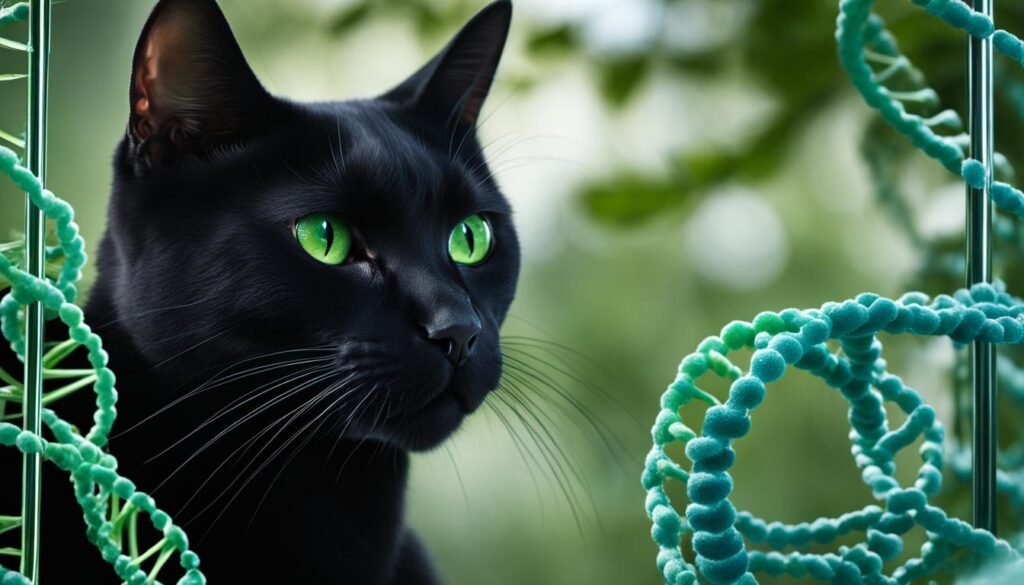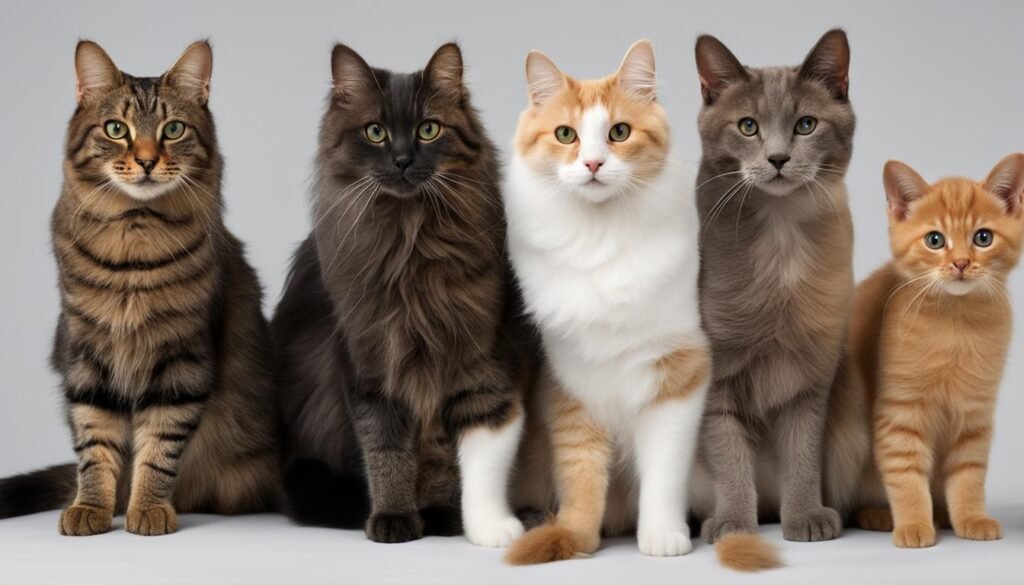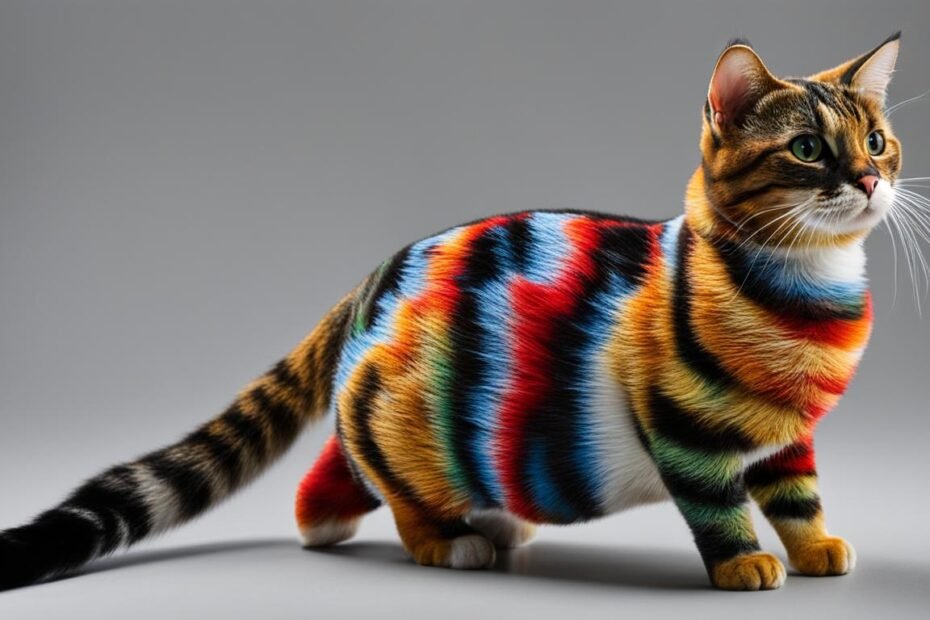Welcome, feline lovers! Cats have always fascinated us with their mysterious behavior and captivating features. In this article, we explore the fascinating world of cat genetics and how it has shaped the evolution of our beloved companions. From their wild ancestors to the diverse breeds we see today, understanding cat genetic changes allows us to appreciate the wonders of nature’s design.
Key Takeaways:
- Cats have evolved from their wild ancestors through genetic changes over thousands of years.
- Selective breeding has led to the development of distinct cat breeds with unique appearances and temperaments.
- Cat genetics influence behavior, including hunting instincts, grooming habits, and territorial behaviors.
- Cat genetics also determine physical traits such as coat color, pattern, eye color, and more.
- The bond between humans and cats has evolved throughout history, with cats playing significant roles in ancient cultures and modern society.
The Physiology of Feline Behavior
Cats possess a fascinating array of behaviors that have evolved over time through genetic adaptation. Their complex neural pathways and hormonal influences shape their unique behaviors, making them the captivating creatures we know and love.
One distinctive behavior in cats is their strong instinct to hunt. This behavior is deeply ingrained in their neural pathways, allowing them to stalk and capture prey with precision. Through centuries of genetic adaptation, cats have honed their hunting skills, making them skilled predators in the wild and even in our homes.
Hormonal influences also play a significant role in shaping cat behavior. Reproductive hormones, in particular, have a profound impact on cats’ aggression, territorial behavior, and mood. These hormonal fluctuations can lead to changes in behavior, especially in unneutered cats. Understanding and managing these hormonal influences is key to providing a harmonious environment for our feline friends.
The fascinating interplay between genetics, neural pathways, and hormonal influences shapes the behavior of cats. By appreciating and understanding these physiological aspects, we can better cater to their needs and ensure a happy and fulfilling life for our beloved feline companions.

Table: Behavioral Characteristics in Cats
| Behavior | Description |
|---|---|
| Hunting | Cats have an innate instinct to hunt, which is guided by their neural pathways and honed through genetic adaptation. |
| Grooming | Cats are meticulous groomers, using their specialized tongues to clean their fur and keep it in optimal condition. |
| Territorial Marking | Cats mark their territories through scent marking, using pheromones to communicate with other cats in the area. |
| Social Behavior | Cats engage in various social behaviors, such as grooming each other, playing, and forming hierarchies within their colonies. |
As seen in the table above, cats exhibit a range of behaviors that are deeply rooted in their genetic makeup. These behaviors have evolved over time and are shaped by the intricate interplay of genetics, neural pathways, and hormonal influences. By understanding and appreciating the physiology of feline behavior, we can provide the best care and environment for our feline companions, allowing them to thrive both physically and emotionally.
The Evolutionary Journey
The evolutionary journey of cats is a fascinating tale of adaptation and survival. Cats have a rich history that can be traced back to their wild ancestors, such as the African wildcat. Over many generations, these ancestral cats evolved in response to their environment, developing unique instincts and characteristics that have shaped them into the beloved feline companions we know today.
Throughout their evolutionary journey, cats have undergone genetic changes that have enabled them to thrive in various habitats. One of the key features that set cats apart is their keen senses. Their acute hearing and vision have evolved to make them highly efficient hunters, allowing them to navigate their surroundings with precision and stealth. Additionally, cats possess excellent reflexes and agility, which have been honed over time to aid in their hunting pursuits.
Another significant evolutionary adaptation in cats is the development of retractable claws. This remarkable trait allows cats to withdraw their sharp claws when not in use, preserving their sharpness and preventing them from getting blunted. Retractable claws are essential for climbing, grasping prey, and self-defense, giving cats an edge in survival.
| Cat Features | Evolutionary Significance |
|---|---|
| Keen senses | Aided in hunting and survival |
| Agility and reflexes | Enhanced hunting abilities |
| Retractable claws | Improved climbing and self-defense |
The bond between humans and cats has also played a crucial role in their evolution. As humans recognized the value of cats as companions and protectors, they began to selectively breed them for specific traits. This selective breeding has led to the development of various cat breeds, each with its own unique appearance and temperament. The evolutionary journey of cats continues to this day as breeders work to refine and enhance these breed-specific traits.
In conclusion, the evolutionary journey of cats is a testament to their incredible adaptability and the beauty of nature’s design. From their wild ancestors to the domesticated breeds we know and love, cats have evolved to become the perfect companions, thanks to their remarkable genetic changes and unique features.
Breed Genesis and Differentiation
The domestication process has played a significant role in the emergence and development of different cat breeds through selective breeding. Humans recognized the value of cats as companions and protectors, leading to intentional breeding to accentuate specific traits and characteristics. Over time, this selective breeding has resulted in the creation of distinct breeds with unique appearances and temperaments.
Each cat breed possesses specific traits that have been selectively bred for, whether it is a certain coat color or pattern, specific health issues, intelligence, athleticism, or even personality traits. For example, the Siamese breed is known for its striking blue eyes and sleek, short coat, while the Maine Coon is recognized for its large size and tufted ears. Understanding these breed-specific traits is crucial for cat owners and breeders alike, as it helps provide the best care and environment for each individual cat.
To further illustrate the differentiation among cat breeds, let’s take a look at the following table:

| Breed | Appearance | Temperament | Health Issues |
|---|---|---|---|
| Siamese | Distinct color points, slim build, short coat | Vocal, social, affectionate | Genetic predisposition to dental issues, respiratory problems |
| Maine Coon | Large size, bushy tail, tufted ears | Gentle, friendly, sociable | Potential hypertrophic cardiomyopathy, hip dysplasia |
| Persian | Long, luxurious coat, flat face, round eyes | Calm, gentle, affectionate | Respiratory issues, polycystic kidney disease |
| Abyssinian | Short, ticked coat, muscular body | Active, playful, curious | Generally healthy, potential renal amyloidosis |
As shown in the table above, each breed possesses unique characteristics that have been selectively bred for. This not only contributes to their physical appearance but also influences their temperament and potential health issues. Understanding these differences allows cat owners to better meet the specific needs of their feline companions, ensuring a happy and healthy life.
Sociocultural Impact
Cats have had a significant impact on human culture throughout history. In ancient Egypt, they were revered as sacred creatures and associated with gods and goddesses. The Egyptians believed that cats brought good fortune and protection. These beliefs led to the worship of cat deities such as Bastet, the goddess of home, fertility, and protection. Egyptians mummified their cats, honoring them in death just as they did in life. The image of the Egyptian cat has become iconic, symbolizing elegance and mystery.
However, during the Middle Ages, cats faced a drastic shift in perception. They were associated with witchcraft and were often targeted and persecuted. The fear and suspicion surrounding cats led to widespread cat killings, as they were believed to be familiars of witches. This persecution caused a decline in the cat population, which led to the proliferation of rodents and the spread of diseases like the Black Plague.
In the 18th and 19th centuries, cats experienced a resurgence in popularity and became symbols of independence and the untamed spirit. Artists and writers depicted cats in their works as mysterious and aloof, embodying qualities that many admired. Cats became a common theme in literature, with notable examples like Edgar Allan Poe’s “The Black Cat” and Charles Baudelaire’s “Les Fleurs du Mal.”
In modern times, the internet has fueled the popularity of cat culture through cat-themed content and the rise of celebrity cats. Memes, videos, and social media accounts dedicated to cats have gained immense popularity, showcasing the various antics and cute moments of feline companions. These online communities have brought cat lovers from around the world together, creating a global network of cat enthusiasts. Cats have become internet stars, with famous feline personalities like Grumpy Cat and Lil Bub capturing the hearts of millions.
Cat Quotes:
“Cats are connoisseurs of comfort.” – James Herriot
“In ancient times, cats were worshipped as gods; they have not forgotten this.” – Terry Pratchett
“I have studied many philosophers and many cats. The wisdom of cats is infinitely superior.” – Hippolyte Taine
Cat Internet Celebrities:
- Grumpy Cat
- Lil Bub
- Nala Cat
- Maru
Interesting Cat Fact:
A group of cats is called a clowder.
Conclusion
Understanding the genetic changes in cats provides fascinating insights into the evolution of their behavior and physical traits over time. Through thousands of years of domestication, cats have developed distinct instincts and characteristics that have made them beloved companions. The interplay of genetic adaptation and selective breeding has resulted in a diverse range of cat breeds, each with their own unique appearances and temperaments.
Not only do cat genetics influence their coat colors, patterns, and distinctive features such as eye color and fur length, but they also play a role in shaping their behavior. Changes in cat behavior over time can be attributed to genetic variations and hormonal influences. From their strong instinct to hunt and groom to their territorial and social behaviors, cats’ genetic makeup is intricately linked to their behavioral patterns.
By studying cat genetics, breeders are able to produce specific coat patterns and colors, ensuring the preservation and enhancement of desirable traits. This knowledge also allows cat lovers to appreciate the incredible diversity of feline companions and the beauty of nature’s design. So next time you marvel at your cat’s unique traits, remember that beneath their charming exterior lies a fascinating genetic history that has shaped them into the incredible creatures they are today.
FAQ
How have cats evolved over time?
Cats have evolved from their wild ancestors over thousands of years, shaping their behavior and physiology. Their instincts and characteristics, such as keen senses, agility, and retractable claws, have helped them thrive in their natural habitats.
What influences cat behavior?
Cats’ behaviors are influenced by their complex neural pathways and hormonal influences. Their neural pathways are finely tuned for hunting, grooming, territorial, and social behaviors. Hormones, particularly reproductive hormones, play a significant role in shaping cat behavior and can lead to changes in aggression, territorial behavior, and mood.
How have humans contributed to the domestication of cats?
Humans recognized the value of cats as companions and protectors, leading to their domestication. This process has also led to the development of various cat breeds through selective breeding, resulting in distinct appearances and temperaments.
How do different cat breeds come about?
The domestication process has allowed for the emergence of different cat breeds through selective breeding. Humans have accentuated specific traits and characteristics to create distinct breeds with unique appearances and temperaments.
What is the historical significance of cats?
Cats have had a significant impact on human culture throughout history. In ancient Egypt, they were revered as sacred creatures and associated with gods and goddesses. In modern times, the internet has fueled the popularity of cat culture through cat-themed content and the rise of celebrity cats.
How do genetics play a role in cat appearance?
The study of cat genetics provides insights into their diverse coat colors and patterns, as well as other unique traits such as fur length, eye color, and polydactylism. Genetic combinations determine a cat’s physical traits, including coat color, pattern, and other distinctive features.
